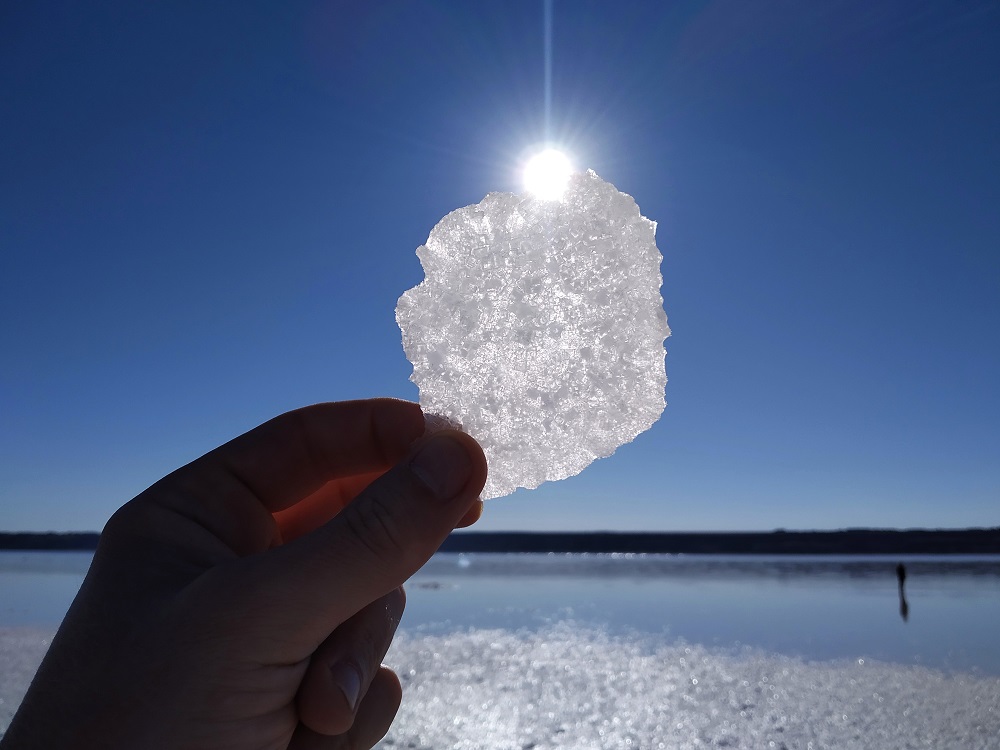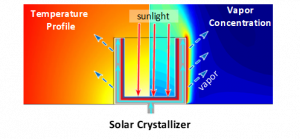
The team’s ‘solar crystallizer’ uses solar energy as the main energy source to heat and evaporate the brine
Read Arabic story here.
Brine is a high-concentration solution of salt in water and is a by-product of many industrial processes, including desalination. The simplest way to dispose of brine is to return it to the ocean, but high localized brine concentrations raise seawater salinity and alkalinity to the point that an environmental risk is created.
Another common way to dispose of brine is to use evaporation ponds, where the water is evaporated and the salt is collected for use in other processes.
Unfortunately, neither method is a fully environmentally-friendly approach, and untreated brine can be corrosive and toxic if disposed of improperly.
A team of researchers, including Khalifa University’s Dr. Tiejun Zhang and Dr. Hongxia Li from the Department of Mechanical Engineering, has designed a new, sustainable way to treat brine without disposing of any water, using the energy from the sun.
Dr. Zhang and Dr. Li published their work in Nature Communications with Chenlin Zhang and Prof. Peng Wang’s group from King Abdullah University of Science and Technology, Saudi Arabia.
The collaborative research team led by Prof. Wang designed a ‘solar crystallizer’ that uses solar energy as the main energy source to heat and evaporate the brine.

“Proper disposal of industrial brine is a critical environmental challenge,” explained Dr. Zhang. “The volumes of brine produced by modern industries range from hundreds of liters to tens of thousands of liters. Conventional methods of disposing brine are detrimental to aquatic ecosystems and land vegetation systems. Concentrating the brine to near saturation and then evaporating the water in a contained system can remove all residual water from the brine to produce solid salts in a zero liquid discharge process.”
Typically, a zero liquid discharge process concentrates the original source brine to near saturation and uses a process known as ‘crystallization’ to remove all the salts from the solution. Brine crystallizers are sometimes used to separate the salt from the water, but they require electricity to heat the brine for water evaporation, resulting in high energy consumption.
“Solar-driven water evaporation is gaining popularity as an environmentally friendly way to produce water vapor for clean water production via solar distillation,” explained Dr. Zhang. “In such a process, solar energy is harvested and converted to heat using a photothermal material, producing water vapor from various source waters in a solar still. Then, the condensate from the water vapor is collected as fresh water.”
Sounds simple, but the amount of salt in the water can affect the light absorption of the photothermal materials, water transport and evaporation in wicking materials.
To solve this, the research team designed a new 3D solar crystallizer device in which the water evaporation surface and the light absorption surface are physically separated by an aluminum sheet with high thermal conductivity. The bottom and inner walls act as the sunlight absorbing component, absorbing 99 percent of the light that hits it, while the outer wall surface serves as the water evaporation surface and salt crystallization surface.
“The high thermal conductivity of the aluminum separator conducts the heat generated at the bottom of the device to its wall for water evaporation,” explained Dr. Li.
“This results in a high solar-to-vapor performance, meaning this simple but promising strategy can provide a low-cost and sustainable solution, especially for small to medium-sized industrial brine treatment.”
Dr. Zhang has teamed up with Dr. Faisal Al Marzooqi to develop more advanced solutions at Khalifa University for sustainable solar brine treatment with anti-fouling, anti-corrosion and anti-scaling performance.
Jade Sterling
Science Writer
31 March 2021






